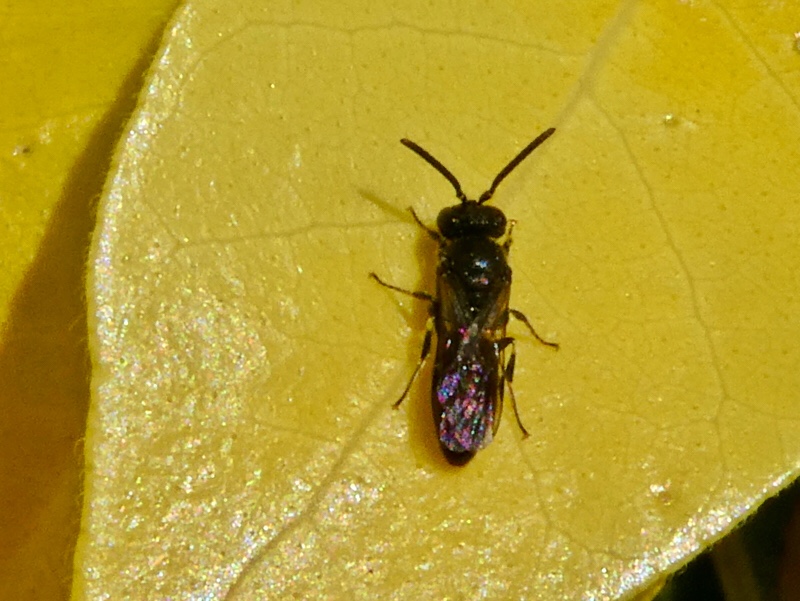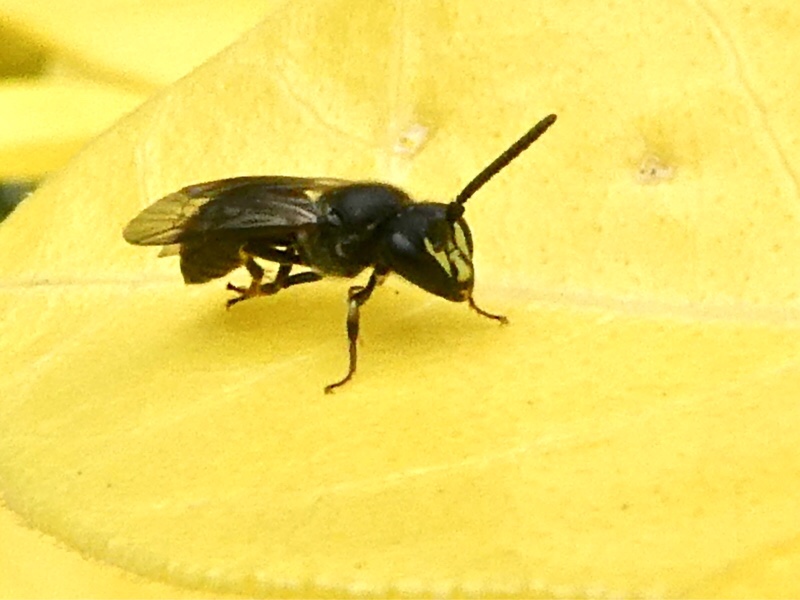Do bees paint their faces?
25 June 2019
I’ve made a surprising and interesting discovery this year in the garden. Perhaps that statement may be a little hyperbole. It’s not a new discovery to science, just to me. When bimbling around the garden this late spring and early summer I’ve noticed a number of very small flying insects zipping around and occasionally landing on the yellow leaves of a Choisia. Up until a couple of weeks ago I dismissed them as some sort on midge, and way beyond my poor identification skills to even consider for a nanosecond to try and ID.

One morning when there was nothing much around I attempted a photograph anyway. Why you may ask. Well, because I could! When I looked at the image on the iPad later that day I was pleasantly surprised to discover that it was a miniature bee. One which had very distinctive facial markings. “Ohhh.....I wonder what that is?” I mumbled to myself. I have to mumble to myself, everyone else in the house tolerates my fumbling forays into the the world of entomology, but are not interested in joining me. After only 5 minutes of leading through my ID books I came up with a provisional identification of Hylaeus communis, or Common Yellow-face Bee. Two hours later my guess, and yes it is always a guess, was confirmed by the gurus on the BWARs Facebook page. I love these specialist Facebook groups who help me, or rather correct me, so often when I find something new.

Let’s get something straight, H.communis is small. Really small. And the male is smaller than the female. Only about 4mm long, so most of the time it looks like a fly black speck of something. It’s only when you get the chance to see one of them magnified that you can see it properly in its miniature perfection. But how small can an insect get and still be able to pack in all the anatomical features to make it a viable organism. Brain, guts, muscles....amazing. The photos are not crystal clear, so I hope you forgive a slight fuzziness, but they were cropped severely to magnify the wee beasties.
H.communis belongs to a genus that comprises more than 500 species worldwide, with 12 of them occurring in the UK. Unlike other bees Hylaeus do not have pollen baskets, but transport pollen in their crop from the flowers back to their nest. And H.communis is no exception. They are classed solitary bees, meaning that they nest as individuals, with each female tending only their own nest. The adults emerge mod-May onwards, and can be seen up until September. I can’t remember seeing them last year, but they may have been there and I just dismissed them as midges, managing to ignore what was under my nose.

The females make their nests in any suitable hole or crevice which may be hollow stems or twigs, holes in wood, walls or soil. They also use bee hotels, so maybe they moved into the hotels I put up last year. Each nest is lined by a waterproof cellulose substance that the female bee produces before laying single eggs in individual cells within the hole. Each cell is provisioned with pollen to feed the growing larva. You’d have thought that something this small would only be a risk be being eaten by something much larger, a wasp or a bird even. That may well be the case, but like almost every other living organism it is at risk of being parasitised. Not as an adult, but at the larval stage. The nests can be attacked by a parasitic wasp Sapyga quinquepuntata, which lays its eggs within the cells. Gasteruption wasps have also been reported as parasites. One intriguing evolutionary development is that in Hawaii some Hylaeus species themselves have become cleptoparasits of other Hylaeus species.
If you want to go out and look for H.communis yourself there is a high chance you’d be successful it’s widely distributed in the south and centre of fo the UK, and is one of the most common Hylaeus to occur in gardens.
References
Falk, S. & Lewington, R. (2015) Field Guide to the Bees of Great Britain and Ireland. Bloomsbury.
I’ve made a surprising and interesting discovery this year in the garden. Perhaps that statement may be a little hyperbole. It’s not a new discovery to science, just to me. When bimbling around the garden this late spring and early summer I’ve noticed a number of very small flying insects zipping around and occasionally landing on the yellow leaves of a Choisia. Up until a couple of weeks ago I dismissed them as some sort on midge, and way beyond my poor identification skills to even consider for a nanosecond to try and ID.

One morning when there was nothing much around I attempted a photograph anyway. Why you may ask. Well, because I could! When I looked at the image on the iPad later that day I was pleasantly surprised to discover that it was a miniature bee. One which had very distinctive facial markings. “Ohhh.....I wonder what that is?” I mumbled to myself. I have to mumble to myself, everyone else in the house tolerates my fumbling forays into the the world of entomology, but are not interested in joining me. After only 5 minutes of leading through my ID books I came up with a provisional identification of Hylaeus communis, or Common Yellow-face Bee. Two hours later my guess, and yes it is always a guess, was confirmed by the gurus on the BWARs Facebook page. I love these specialist Facebook groups who help me, or rather correct me, so often when I find something new.

Let’s get something straight, H.communis is small. Really small. And the male is smaller than the female. Only about 4mm long, so most of the time it looks like a fly black speck of something. It’s only when you get the chance to see one of them magnified that you can see it properly in its miniature perfection. But how small can an insect get and still be able to pack in all the anatomical features to make it a viable organism. Brain, guts, muscles....amazing. The photos are not crystal clear, so I hope you forgive a slight fuzziness, but they were cropped severely to magnify the wee beasties.
H.communis belongs to a genus that comprises more than 500 species worldwide, with 12 of them occurring in the UK. Unlike other bees Hylaeus do not have pollen baskets, but transport pollen in their crop from the flowers back to their nest. And H.communis is no exception. They are classed solitary bees, meaning that they nest as individuals, with each female tending only their own nest. The adults emerge mod-May onwards, and can be seen up until September. I can’t remember seeing them last year, but they may have been there and I just dismissed them as midges, managing to ignore what was under my nose.

The females make their nests in any suitable hole or crevice which may be hollow stems or twigs, holes in wood, walls or soil. They also use bee hotels, so maybe they moved into the hotels I put up last year. Each nest is lined by a waterproof cellulose substance that the female bee produces before laying single eggs in individual cells within the hole. Each cell is provisioned with pollen to feed the growing larva. You’d have thought that something this small would only be a risk be being eaten by something much larger, a wasp or a bird even. That may well be the case, but like almost every other living organism it is at risk of being parasitised. Not as an adult, but at the larval stage. The nests can be attacked by a parasitic wasp Sapyga quinquepuntata, which lays its eggs within the cells. Gasteruption wasps have also been reported as parasites. One intriguing evolutionary development is that in Hawaii some Hylaeus species themselves have become cleptoparasits of other Hylaeus species.
If you want to go out and look for H.communis yourself there is a high chance you’d be successful it’s widely distributed in the south and centre of fo the UK, and is one of the most common Hylaeus to occur in gardens.
References
Falk, S. & Lewington, R. (2015) Field Guide to the Bees of Great Britain and Ireland. Bloomsbury.



Comments
Post a Comment